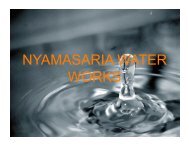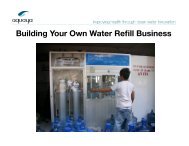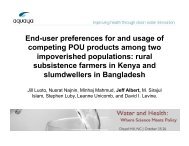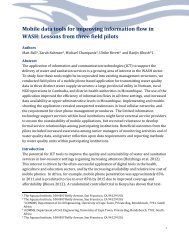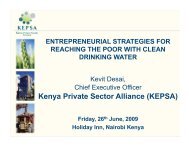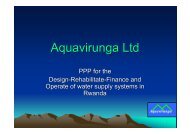Standard Operating Procedure for the Deployment of Procter - Aquaya
Standard Operating Procedure for the Deployment of Procter - Aquaya
Standard Operating Procedure for the Deployment of Procter - Aquaya
Create successful ePaper yourself
Turn your PDF publications into a flip-book with our unique Google optimized e-Paper software.
1<strong>Standard</strong> <strong>Operating</strong> <strong>Procedure</strong> <strong>for</strong> <strong>the</strong><strong>Deployment</strong> <strong>of</strong> <strong>Procter</strong> & Gamble’sPUR Purifier <strong>of</strong> Waterin Emergency Response SettingsThe Problem:Drinking WaterContaminationA Solution:PURContaminated drinking water is a major problem during emergencies. Twomajor sources <strong>of</strong> contamination are microbial pathogens and suspendedmatter.Pathogens. Microbial contamination <strong>of</strong> water occurs when human and animalfecal matter comes into contact with drinking water sources (such as rivers, lakes,ponds, or groundwater wells). It is common during floods and also during o<strong>the</strong>rinstances <strong>of</strong> population displacement because water sources relied upon by displacedpeople are frequently <strong>of</strong> poor quality and rarely treated prior to <strong>the</strong> humanitarianresponse.Since diarrhea is a central symptom <strong>of</strong> gastro-intestinal infections, many water-relatedillnesses are referred to as diarrheal diseases. The waterborne microorganismsthat cause diarrheal diseases are:(1) bacteria – primarily <strong>of</strong> <strong>the</strong> coli<strong>for</strong>m family (e.g. E. coli, Salmonella and Shigella),(2) protozoan parasites (e.g. Giardia and Cryptosporidium), and(3) viruses (e.g. Norwalk and Rotavirus).Suspended Matter. Suspended solid material (varying combinations <strong>of</strong> sediment– mud – and organic matter) is also common in contaminated water sources. Dependingon <strong>the</strong>ir sources, <strong>the</strong>se suspended solids can create health risks in additionto generating unpleasant tastes and odors. Contaminated rivers, lakes, ponds,and wells are frequently “turbid” – laden with a high suspended matter load.PUR is a powdered mixture that removes pathogenic microorganisms and suspendedmatter, rendering previously contaminated water safe to drink. PUR wasdeveloped by <strong>Procter</strong> & Gamble (P&G) in collaboration with <strong>the</strong> US Centers <strong>for</strong> DiseaseControl and Prevention (CDC). PUR contains a chlorine disinfectant (calciumhypochlorite) <strong>for</strong> killing bacteria and an iron salt coagulant (ferric sulfate) <strong>for</strong> removingsuspended matter, protozoa, and viruses. It also contains a buffer, clay andpolymer to provide good coagulation and flocculation. All <strong>of</strong> <strong>the</strong> ingredients usedin PUR are used to purify drinking water in <strong>the</strong> United States and o<strong>the</strong>r developedcountries. The difference is that PUR provides <strong>the</strong>se ingredients at <strong>the</strong> householdlevel ra<strong>the</strong>r than in a centralized treatment facility.PUR is safe <strong>for</strong> long-term use by <strong>the</strong> entire family, including infants, and is consideredan effective technology by <strong>the</strong> World Health Organization (WHO). PUR’sapplication results in water quality that meets WHO guidelines.
2Supplies Neededto Use PURIn field and laboratory studies, PUR has been proven to eliminate disease-causingmicroorganisms and to remove virtually all suspended material. PUR results inremoval <strong>of</strong> more than 99.99999% <strong>of</strong> bacteria (including those that cause choleraand typhoid fever), 99.99% <strong>of</strong> intestinal viruses (including those that cause hepatitisA), and 99.9% <strong>of</strong> protozoa (including Giardia and Cryptosporidum). In randomizedcontrolled health intervention studies, PUR has been proven to reduce diarrhealdisease incidence by up to 90%, with an average <strong>of</strong> about 50%.CARE, CDC, AmeriCares, Johns Hopkins University, and <strong>the</strong> <strong>Aquaya</strong> Institute haveindependently monitored PUR in a variety <strong>of</strong> emergency situations, including floods,refugee camps, and nutrition feeding programs, and concluded that PUR is bothpractical to use and results in a reduction in diarrheal illness. More than 200 millionliters <strong>of</strong> safe drinking water have been provided by global relief groups using PURincluding UNICEF, AmeriCares, Samaritan’s Purse, WorldVision, and o<strong>the</strong>rs in morethan 14 countries. P&G received <strong>the</strong> 2005 Stockholm Industry Water Award <strong>for</strong> itsef<strong>for</strong>ts to provide PUR sachets to global relief groups.PUR comes in a 4 gram sachet labeled in English. Each sachet treats 10 liters <strong>of</strong>water. The sachets arrive from <strong>the</strong> manufacturing facility in cartons containing 20strips <strong>of</strong> 12 sachets each, <strong>for</strong> a total <strong>of</strong> 240 sachets per carton. Each carton is 25cm x 11 cm x 15.5 cm (length, width, height).PUR requires only a few simple tools that most target beneficiaries <strong>of</strong> disaster assistanceshould have at <strong>the</strong>ir disposal:• a scissor or knife to open <strong>the</strong> sachet,• a spoon or o<strong>the</strong>r implement to stir <strong>the</strong> water,• a cloth fabric to filter <strong>the</strong> treated water, and• two vessels (i.e. buckets) with volume capacity <strong>of</strong> 10 liters or more – <strong>the</strong> firstto be used <strong>for</strong> <strong>the</strong> treatment process and <strong>the</strong> second to be used <strong>for</strong> storing<strong>the</strong> treated water.
3How to Use PUR(see also previous page)O<strong>the</strong>r ImportantTips <strong>for</strong>PUR ApplicationThe treatment procedure is as follows:1. Open a PUR sachet using a pair <strong>of</strong> scissors. Add <strong>the</strong> contents <strong>of</strong> <strong>the</strong>sachet to a vessel containing 10 liters (2.5 gallons) <strong>of</strong> contaminated water.One simple way to measure a 10 liter volume is to use a 2-liter bottle fivetimes. Extreme precision is unnecessary: if <strong>the</strong>re are slightly more or lessthan 10 liters, <strong>the</strong> treatment procedure will still be effective.2. Stir <strong>the</strong> powder steadily and vigorously in <strong>the</strong> water <strong>for</strong> five minutes.After adding <strong>the</strong> powder to <strong>the</strong> water, <strong>the</strong> water will become temporarilycolored, and after a minute or two, large particles or “floc” will begin to <strong>for</strong>m,with <strong>the</strong> water becoming clear in <strong>the</strong> process. At <strong>the</strong> end <strong>of</strong> five minutes, stopstirring and let <strong>the</strong> floc settle to <strong>the</strong> bottom <strong>of</strong> <strong>the</strong> container. If <strong>the</strong> water is stillcolored, it can be mixed again and left to rest <strong>for</strong> ano<strong>the</strong>r few minutes.3. Once <strong>the</strong> water looks clear, and <strong>the</strong> floc, or precipitated material, is at<strong>the</strong> bottom <strong>of</strong> <strong>the</strong> bucket, filter <strong>the</strong> water through a clean cloth into a cleanstorage container. The filter must be a cotton cloth that prevents <strong>the</strong> flocparticles from passing through.4. Wait 20 minutes be<strong>for</strong>e drinking <strong>the</strong> water. This is an important step,because it is during this time that remaining pathogenic bacteria are killed.The water should be stored in a container with a lid if available to keep it safefrom recontamination.- Roughly a single sachet per household per day <strong>for</strong> emergency use is anappropriate amount <strong>for</strong> distribution. Two 12-sachet strips will treat 240 liters<strong>of</strong> water, and should be sufficient to support a household <strong>for</strong> three weeks.- It is important to stir <strong>the</strong> water vigorously <strong>for</strong> <strong>the</strong> floc to <strong>for</strong>m properly. Thisvisual sign is <strong>the</strong> signal that <strong>the</strong> product is working properly. The floc will<strong>for</strong>m even if PUR is added to clear water.- The floc from <strong>the</strong> water treatment process should be disposed <strong>of</strong> in <strong>the</strong>latrine or on <strong>the</strong> ground away from children and animals.- Water that is still colored or cloudy after treatment should not be drunk.If floc accidentally gets into <strong>the</strong> treated water (by accidentally dropping <strong>the</strong>filter cloth into <strong>the</strong> water, <strong>for</strong> example), <strong>the</strong>n ano<strong>the</strong>r cloth should be used torefilter <strong>the</strong> treated water into a clean container.- The chlorine in <strong>the</strong> water gradually disappears, and after 24 hours it will notbe present in sufficient concentration to remove microbes. It is important tostore and dispense drinking water so as to avoid recontamination.- Water from <strong>the</strong> storage container should always be dispensed into ano<strong>the</strong>rcontainer, such as a cup or glass <strong>for</strong> drinking. Unwashed hands and utensilsshould never be dipped into <strong>the</strong> treated water because this is how treatedwater becomes re-contaminated. A solid cover on <strong>the</strong> treated water is preferred.If a lid is not available, a large plate or a towel may be used.- A simple test to determine whe<strong>the</strong>r <strong>the</strong> cloth is adequate is to use it to filter<strong>the</strong> water. If <strong>the</strong> “floc” does not pass through <strong>the</strong> cloth <strong>the</strong>n it is workingcorrectly. A cotton cloth works best and you should not be able to seethrough <strong>the</strong> cloth. On <strong>the</strong> o<strong>the</strong>r hand, <strong>the</strong> cloth should not be so thick that ittakes a prohibitively long time to filter <strong>the</strong> water.
4Recommendations<strong>for</strong> OvercomingPotential Obstaclesto a SuccessfulDistribution <strong>of</strong> PURA number <strong>of</strong> factors may limit <strong>the</strong> adoption <strong>of</strong> PUR in disaster settings and must beaddressed to achieve successful PUR distribution:(1) Lack <strong>of</strong> familiarity with <strong>the</strong> product and its usage, resulting in misperceptions<strong>of</strong> labor and time demand, and associated logistical challenges,(2) chlorine odor and taste,(3) color change during treatment process,(4) lack <strong>of</strong> available buckets and cloth, and(5) acceptance by governent <strong>of</strong>ficials and community leaders.Each <strong>of</strong> <strong>the</strong>se obstacles should be carefully addressed in order to achieve asuccessful PUR distribution. Experience with PUR in a variety <strong>of</strong> emergency reliefsituations has shown that by addressing <strong>the</strong>se obstacles with a team <strong>of</strong> trainers,emergency relief groups can successfully distribute PUR.Familiarization and education on PUR usage. PUR is a new product that manydisaster victims will not recognize. To be most effective, PUR should be distributedto communities with an accompanying demonstration <strong>of</strong> its usage. Teams <strong>of</strong> emergencyresponders should train hygiene educators to per<strong>for</strong>m initial demonstrationsas well as provide an opportunity <strong>for</strong> follow-up questions by community members.A demonstration in which <strong>the</strong> presenter prepares PUR-treated water using a localsource <strong>of</strong> water is <strong>the</strong> best way to educate people on proper use. It is importantthat <strong>the</strong> presenter drink <strong>the</strong> water at <strong>the</strong> end <strong>of</strong> <strong>the</strong> presentation to show confidencein <strong>the</strong> product. The presentation should emphasize that <strong>the</strong> amount <strong>of</strong>labor required <strong>for</strong> using PUR is roughly five minutes, even though <strong>the</strong> full treatmentprocess requires 30 minutes. The instructions <strong>for</strong> using PUR should be provided in<strong>the</strong> local language(s). An effective way to do this is to translate <strong>the</strong> instructions intolocal language(s) and put <strong>the</strong>m, along with <strong>the</strong> pictorial instructions, on a laminatedcard or on a sticker that can be provided with or on <strong>the</strong> buckets.Education around chlorine taste and odor. PUR-treated water will have a chlorinetaste similar to municipal water in developed countries. In many circumstancesPUR will be distributed to people who have never been served by an improvedwater supply and who are not accustomed to chlorine taste and odor. Experiencehas shown us, however, that consumers will come to accept chlorine taste if <strong>the</strong>yunderstand <strong>the</strong> importance <strong>of</strong> chlorine in removing microbial pathogens. Disastersurvivors must be told during <strong>the</strong> product demonstration that <strong>the</strong> water will havea chlorine odor and taste that will diminish over a few hours, and that <strong>the</strong>se odorsand tastes are indicators <strong>of</strong> water safety. If people find <strong>the</strong> taste objectionable, <strong>the</strong>ycan be advised to prepare <strong>the</strong> water at night so that much <strong>of</strong> <strong>the</strong> chlorine taste willdissipate by <strong>the</strong> following morning.Explaining <strong>the</strong> color change. A PUR demonstration must highlight <strong>the</strong> fact that acolor change or darkening <strong>of</strong> even clear water will occur when <strong>the</strong> PUR powder isadded to <strong>the</strong> water. This is an indication that <strong>the</strong> product is working properly. Thecolor might be orange or brown depending on <strong>the</strong> nature <strong>of</strong> <strong>the</strong> source waters.The final drinking water should be clear.Adequate supplies <strong>of</strong> containers and cloth. Under certain emergency conditions,containers such as buckets and jerry cans may not be available. In <strong>the</strong>secases, <strong>the</strong>se supplies will need to be provided with PUR. It is important that beneficiariespossess <strong>the</strong> tools necessary to conduct <strong>the</strong> PUR procedure.Acceptance by governent <strong>of</strong>ficials and community leaders. It is importantto engage governent <strong>of</strong>ficials and community leaders so that <strong>the</strong>y understand thatPUR is a quality product, safe <strong>for</strong> <strong>the</strong>ir communities, and will provide an effectiveand practical solution to providing emergency drinking water. The emergencyresponse needs to be coordinated with <strong>the</strong> local government recommendationsso that <strong>the</strong>re are not conflicting messages. For example, <strong>the</strong> community may notunderstand that <strong>the</strong>re is no need to both boil water and use PUR.
When notto Use PURIn addition to pathogenic microbes and suspended matter, PUR also has beenshown to significantly reduce concentrations <strong>of</strong> pesticides like DDT as well as o<strong>the</strong>rhigh molecular-weight organic chemicals and particulate-fraction (undissolved)heavy metals. Arsenic levels, <strong>for</strong> example, are significantly reduced by PUR.There are, however, some water contaminants not removed by PuR. These include:• salinity,• nitrate and fluoride,• low molecular-weight organic chemicals (such as industrial solvents like TCE,PCE, and vinyl chloride), and• dissolved heavy metals in high concentrations, such as would be found inmine tailings.The above are not common contaminants in disaster response settings, but it isimportant to know when <strong>the</strong>y are a problem, and not to deploy PUR when thosecontaminants are a major concern.Finally, provision <strong>of</strong> household water treatment approaches such as PUR shouldbe considered as part <strong>of</strong> a coordinated response to an emergency situation. Forexample, in some emergency relief situations it may be easier to distribute tankeredor bottled water.AdditionalResourceshttp://www.pghsi.com/safewater/ - P&G Health Sciences Institutehttp://www.who.int/household_water/en/ - WHO International Network <strong>for</strong><strong>the</strong> Promotion <strong>of</strong> Household Water Treatment and Safe Storagehttp://www.who.int/water_sanitation_health/dwq/wsh0207/en/index.html- Managing Water in <strong>the</strong> Home: accelerated health gains from safe watersupply. Mark Sobsey, PhD., University <strong>of</strong> North Carolina, <strong>for</strong> WHO.



